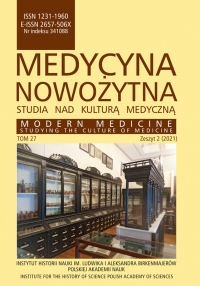Terra sigillata Silesiaca – historyczne pokłady śląskiej gliny leczniczej jako środek terapeutyczny
Terra sigillata Silesiaca – historical deposits of Silesian medicinal clay as therapeutic agent
Author(s): Izabela Spielvogel, Maria PająkSubject(s): History, Local History / Microhistory
Published by: Wydawnictwo Uniwersytetu Jagiellońskiego
Keywords: history of medicine; Silesian medicinal clay; terra sigillata Silesiaca; Silesia
Summary/Abstract: Clays, because of their medicinal properties, have been intuitively used in healing in all parts of the world since ancient times. The discovery of medicinal clay deposits used in Silesia – terra sigillata Silesiaca – dates back to 1550. The deposits were described in 1586 in a work published in Nuremberg entitled Judieum de terra sigillata strigoviensis. The author of the publication was the discoverer of Silesian healing clays – a Renaissance physician and geologist from Strzegom – Johann Schulz (1531–1604), known as Johannes Montanus. This discovery was also mentioned in 1583 by Andreas Berthold, an alchemist and empiricist, who was not a physician, in his work entitled Terrae sigillatae nuper in Germania repertae and Caspar Schwenckfeld (1563–1609), a spa physician from Cieplice-Zdrój, in his monograph from 1600, entitled Stirpium & Fossilium Silesiae Catalogus. Indications for using clay from Silesian deposits were also described in a work from 1737, entitled Rariora naturae & artis, item in re medica; oder, Seltenheiten der Natur und Kunst des kundmannischen Naturalien-Cabinets, wie auch in der Artzeney-Wissenschafft by Johann Kundmann (1684–1751), a physician of the von Hochberg family from Wrocław. By 1580, Silesian clay was already known as a remedy against dog rabies in the state of Hesse. In 1618, it was listed in the pharmaceutical work entitled Pharmacopoetia Londinensis, alongside clays from the Mediterranean region. According to the descriptions, this clay helped the population in 1633 as a prophylactic measure to control the plague epidemic and the mass extinction of cattle in Upper Silesia.
Journal: Medycyna Nowożytna Studia nad Kulturą Medyczną
- Issue Year: 27/2021
- Issue No: 2
- Page Range: 27-44
- Page Count: 18
- Language: Polish

